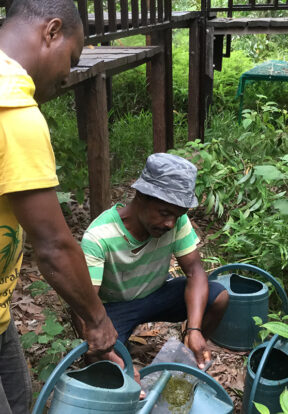Uninvited Guests Heading for the “Buffet” in Kianjavato

IUCN Save Our Species grantees, Omaha’s Henry Doorly Zoo and Aquarium (OHDZA) and Madagascar Biodiversity Partnership (MBP), are working hard to combat this through their reforestation programme.
OHDZA and MBP are focusing on planting native species to replenish and rejuvenate impacted forests, such as, for example, Harungana madagascariensis, known locally as ‘Harongana’. It is an important part of the reforestation programme, and according to Dr. Louis, Director of MBP, it is “a favourite of woolly lemurs”.
Unfortunately, the thousands of seedlings in their reforestation nurseries also make for a convenient buffet for pests, and recently a new, a new culprit has made an appearance. It turns out that Harongana is also a delicacy favoured by a very small, black and yellow caterpillar.
These tiny caterpillars are leaving dozens of small holes in the Harongana, which is proving especially damaging to the seedlings. Fortunately, Head Groundskeeper, Dominique Randrianekena, has been experimenting with organic pest controls, following on from a workshop he attended last year.
It’s like traditional medicine for your vegetables!
Dominique Randrianekena, Head Groundskeeper at the Kianjaveto Ahmanson Field Station
To create his special recipe, Dominique pounds Chinaberry leaves (Melia azedarach), a tree known locally as Voandelaka, and leaves them to soak overnight. The paste is then filtered and poured onto the plants affected by insects. Having already had success in using this method to protect vegetables, Dominique is now testing its use on the Harongana to see if it can help protect a “lemur favourite” from the damaging caterpillars.
The success of projects like the reforestation programme in Kianjavato relies on people who are creative and willing to experiment and learn from results – just like Dominique. His latest invention is a great example of how local expertise can be utilised to improve efficiency of the reforestation programme without a heavy cost – both financially and environmentally. It really highlights how encouraging an exchange of ideas between organisations and individuals can help bolster the conservation effort.







